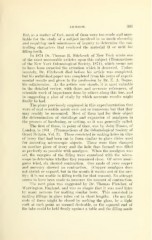Page 623 - My FlipBook
P. 623
AMALGAM. 301
But, as a matter of fact, most of them were too crude and unre-
liable for the study of a subject involved in so much obscurity
and requiring such minuteness of in([uiry to deiei'niine the con-
trolling characters that rendered the material fit or unfit for
filling teeth.
In 1874 Dr. Thomas B. Hitchcock of New York wrote one
of the most memorable articles upon this subject (Transactions
of the New Yoi'k Odontological Society, 1874), which seems not
to have been awarded the attention which it deserved. Unfor-
tunately, Dr. Hitchcock died before his article was completed,
but his unfinished paper was completed from his notes of experi-
mental results and given to the profession jjy Dr. E. A. Bogue,
his collaborator. As the article now stands, it is most valuable
in the detailed review, with dates and accurate references, of
scientific work of importance done by others along this line, and
in suggesting a plan of study by which accurate results might
finally be had.
The plans previously emi)loyed in this experimentation that
were of real scientific merit were not so nmnerous but that they
may readily be recounted. Most of them had for their object
the determination of shrinkage and expansion of amalgam in
the process of hardening, or setting, as it was generally called.
The first of these, in point of time, was by John Tomes, of
London, in 1861. (Transactions of the Odontological Society of
Great Britain, Vol. 3). These consisted in making holes in slips
of ivory that had been cut in form similar to glass slides used
for mounting microscopic objects. These were then clamped
on another piece of ivory and the hole thus formed was filled
as perfectly as possible with amalgam. When the amalgam was
set, the margins of the filling were examined with the micro-
scope to determine whether they remained close. Of seven amal-
gams tried, six showed contraction. One made of pure copper
and mercury showed no contraction. (Copper amalgam does
not shrink or expand, but in the mouth it wastes out of the cav-
ity; it is not usable in filling teeth for that reason). No attempt
seems to have been made to measure the amount of contraction.
The next plan was suggested by Dr. Thomas Fletcher, of
Warrington, P]ngland, and was so simple that it was used later
by many persons for making similar tests. This consisted in
making fillings in glass tubes cut in short lengths. (In use the
ends of these might be closed by melting the glass, by a tight
cork at such point as seemed desirable, or the squared end of
the tube could be held firmly against a table and the filling made


